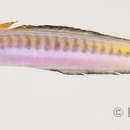Diagnostic Description
(
Anglèis
)
fornì da Fishbase
About 20 oblong segments form the dark midlateral body stripe (Ref. 4404).
- Recorder
- Cristina V. Garilao
Life Cycle
(
Anglèis
)
fornì da Fishbase
Oviparous, distinct pairing (Ref. 205).
Morphology
(
Anglèis
)
fornì da Fishbase
Dorsal spines (total): 7 - 9; Dorsal soft rays (total): 34 - 39; Analspines: 2; Analsoft rays: 28 - 33
- Recorder
- Cristina V. Garilao
Biology
(
Anglèis
)
fornì da Fishbase
Adults inhabit clear lagoon and seaward reefs (Ref. 9710), usually the lower surge zone to deeper areas. They hide in deserted worm tubes when alarmed (Ref. 1602). They feed by attacking other fishes and removing dermal tissue, mucus and sometimes scales; occasionally makes harmless 'attacks' on divers (Ref. 2334, 48636). Some individuals usually strike from behind and quickly dive in the reef for cover to avoid punishment (Ref. 48636). Their wriggling swimming mode possibly mimics other non-scale eating species. Oviparous. Eggs are demersal and adhesive (Ref. 205), and are attached to the substrate via a filamentous, adhesive pad or pedestal (Ref. 94114). Larvae are planktonic, often found in shallow, coastal waters (Ref. 94114). Minimum depth of 1 m reported from Ref. 90102.
- Recorder
- Estelita Emily Capuli
Importance
(
Anglèis
)
fornì da Fishbase
aquarium: commercial
- Recorder
- Estelita Emily Capuli
分布
(
Anglèis
)
fornì da The Fish Database of Taiwan
分布於印度-太平洋區,由紅海至南非起迄萊恩、馬貴斯及土木上群島,北至日本南部,南至紐西蘭、羅得豪島等。台灣各地皆有分布。
利用
(
Anglèis
)
fornì da The Fish Database of Taiwan
小型魚類,僅具學術研究價值,或水族觀賞用。
描述
(
Anglèis
)
fornì da The Fish Database of Taiwan
體長形;鰓裂至胸鰭最末軟條基部。頭無鬚;吻為肉質狀的圓錐形,口下位;齒骨具一彎區大犬齒。無側線。D.
VII-IX, 34-39; A. II, 28-33; P. 12; V. I,
3。背鰭連續無缺刻;背鰭、臀鰭和尾柄相連;尾鰭內凹形,具梳狀後緣。頭部在眼下緣以上為褐色,頭下半部灰白色;體灰白至淺褐色,自眼至尾鰭末端有一黑褐色縱帶,縱帶上具明暗不同的橫紋;縱帶上方在背鰭基部另具一細縱帶;背鰭背鰭基部色淡,末端棕色,鰭緣具一細白線;臀鰭與背鰭相同;除尾鰭內側軟條外,尾、胸和腹鰭灰白色。
棲地
(
Anglèis
)
fornì da The Fish Database of Taiwan
主要棲息於清澈且長滿珊瑚的潟湖區或珊瑚礁向海面,深度範圍從1公尺到40公尺。發現有危險時,會躲在管蟲類遺留下來的空殼中,以躲避敵害。具擬態行為,模擬「魚醫生」以便趁其它魚不注意時,偷襲並咬下其身上的皮膚和黏液腺,甚至是鱗片。
Mimic blenny
(
Anglèis
)
fornì da wikipedia EN
The mimic blenny or piano fangblenny, Plagiotremus tapeinosoma, is a blenny of the genus Plagiotremus, with a widespread Indo-Pacific distribution including New Zealand from depths of 8 to 30 metres (26 to 98 ft). This species reaches a length of 14 centimetres (5.5 in) TL.[2]
References

- licensa
- cc-by-sa-3.0
- drit d'autor
- Wikipedia authors and editors
Mimic blenny: Brief Summary
(
Anglèis
)
fornì da wikipedia EN
The mimic blenny or piano fangblenny, Plagiotremus tapeinosoma, is a blenny of the genus Plagiotremus, with a widespread Indo-Pacific distribution including New Zealand from depths of 8 to 30 metres (26 to 98 ft). This species reaches a length of 14 centimetres (5.5 in) TL.
- licensa
- cc-by-sa-3.0
- drit d'autor
- Wikipedia authors and editors
Description
(
Anglèis
)
fornì da World Register of Marine Species
Inhabits seaward reefs, usually the lower surge zone to deeper areas. Hides in deserted worm tubes when alarmed (Ref. 1602). Feeds by attacking other fishes and removing dermal tissue, mucus and sometimes scales; occasionally makes harmless 'attacks' on divers (Ref. 2334).
Froese, R. & D. Pauly (Editors). (2023). FishBase. World Wide Web electronic publication. version (02/2023).
- licensa
- cc-by-4.0
- drit d'autor
- WoRMS Editorial Board

